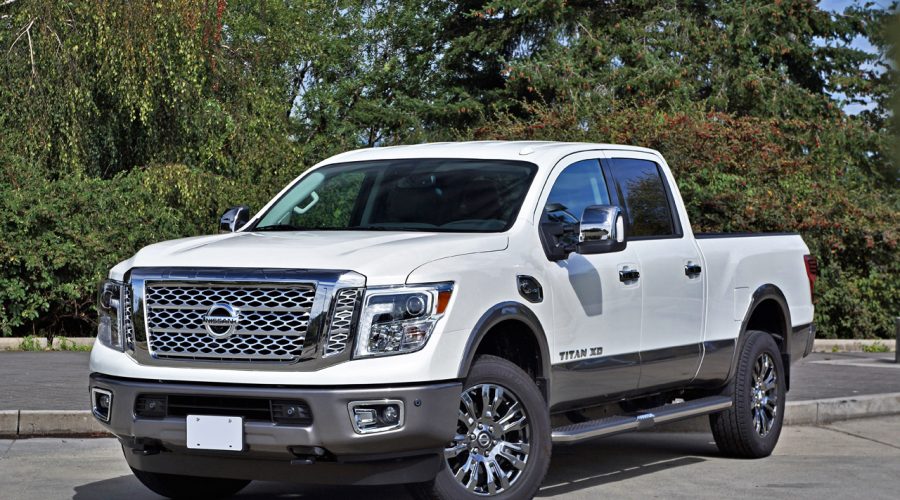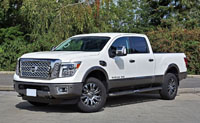
Anyone still questioning whether the full-size pickup truck market is a tough nut to crack for imports hasn’t been paying attention.
Toyota has arguably done a better job than Nissan over the long haul, although when comparing deliveries to the big three we’re talking petite potatoes either way. Toyota sold 9,442 Tundras to 5,692 Nissan Titans in 2017, whereas Ram sent 98,465 Pickups down Canadian roads last year, General Motors improved on that number with 120,949 Chevy Silverado and GMC Sierra deliveries, and Ford once again topped the charts with 155,290 F-Series sales.
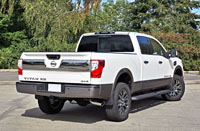
Those were the highest big three truck totals in history, while Nissan also gets kudos for selling more Titans than ever before, but despite an upturn in truck sales and Canada’s best-ever year of vehicle sales, Toyota lost a lot of half-ton ground. Why? It wouldn’t be out of the question to point fingers at the new Titan, especially when factoring in last year’s sales were up 2,466 units and the Tundra’s were down 1,922, but it could also be that loyal Toyota owners are merely waiting patiently for a long expected Tundra update, whereas equally supportive Nissan buyers were feasting on the new-for-2017 gasoline-powered half-ton Titan.
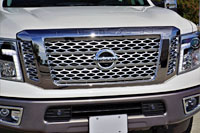
The Cummins Diesel-powered Titan XD arrived on the Canadian market for the 2016 model year, and while it did well such big heavy-half pickup trucks aren’t for everyone. Then again the Titan XD makes a lot of sense for trailer-pulling folks, whether the load is construction equipment or landscaping fill for your business, or personal recreation gear like a camper, boat or horses. The truck I tested was capable of 5,457 kilos (12,030 lbs) of trailering weight and a payload of 907 kg (2,000 lbs) (max payload is 1,143 kg/2,520 lbs), and can even be had with a Nissan-sourced fifth-wheel hitch integrated into the bed. Want to check your trailer’s lights once it’s hooked up? The Titan team has thought of everything, providing you opt for second-rung SV trim (or higher) with its standard key fob actuated trailer light tester.
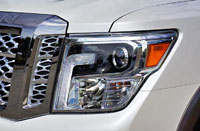
My top-line XD Platinum had that familiar highway rig look thanks to copious chrome detailing, most notably across the front grille, the rear tailgate, the mirror caps, door handles, alloy wheels, and various trim bits. It’s a darkened chrome for a richer look, softened slightly by my tester’s Pearl White and taupe grey Titanium metallic two-tone effect paint, yet still pretty glitzy for the campground crowd.
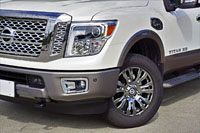
Let’s face it. When driving up in a Titan you’re not going to enjoy the camaraderie of F-Series owners wandering over from the adjacent campsite to see the latest Limited, or for that matter the Silverado/Sierra bunch fawning over the newest High Country/Denali, let alone the Ram gang making googly eyes at the Laramie Limited. You’ll get the odd curious albeit wary wonderer trying to get a closer look at what’s available from the dark side, unaware the Titan is made in the U.S.A., Canton, Mississippi to be exact.
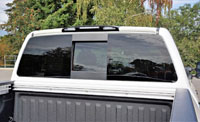
Be prepared for some deep frowns from heavy-duty Ram fans who think their HD 2500 and 3500 models have an exclusive right to Cummins Diesel power. The Columbus, Indiana company supplies both brands now, but don’t go spouting off engine output numbers or you’ll put smiles right back on their faces, being that the Titan XD Cummins Diesel doesn’t put out anywhere near the performance of the Ram HD, the domestic truck’s 7,403 kg (16,320-lb) tow rating the result of a 6.7-litre I-6 with 410 horsepower and 800 lb-ft of torque. It appears not all Cummins diesels are created equal.
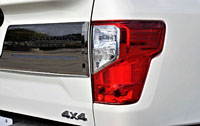
Of course, the Titan XD isn’t a three-quarter or one-ton pickup truck, and therefore doesn’t need as much capability. Most should find the 310 horsepower and 555 lb-ft of torque from its DOHC, 32-valve Cummins 5.0-litre V8 equal to their requirements, while many will be just as satisfied with the 390 horsepower and 394 lb-ft of torque from the base 5.6-litre gasoline-powered V8, an engine that wasn’t available for the 2016 launch model.
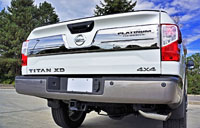
On that note, Nissan Canada has made some changes for 2018. First and foremost they’ve dropped the Single Cab XD, which means there’s no longer a 4×2 variant and entry-level pricing has therefore increased from 2017’s $37,250 to $47,498 for the new base 2018 XD Crew Cab S 4×4, or $54,998 with the diesel. While plenty more now comes standard, including an extra set of doors, a second row and four-wheel drive, the new base price represents a $748 increase over last year’s identical XD Crew Cab S.
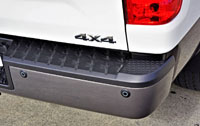
While eliminating body styles is never good for a model that was created for fighting it out in domestic full-size truck territory where variety is king, Nissan has obviously wizened to the fact it’s not going to make much headway into the Canadian commercial light truck market dominated by the big three, so the slow-selling Single Cab had to go in our smaller market (it’s still available in the U.S., as is the mid-range King Cab). The U.S. market still offers SL trim as well (it was previously second from the top), with the Canadian 2018 XD lineup now pared down to S, SV, Pro-4X, and Platinum trims, while each can be had with either gasoline or diesel powerplants.
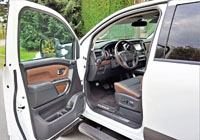
No matter which engine you choose features are the same, but keep in mind S trim is pretty basic. Its standard pushbutton ignition is a bit of an upscale surprise, as is the dampened-assist tailgate, but bringing it back down to earth are 17-inch steel wheels, manually adjustable side mirrors, and a smallish 5.0-inch display audio system with AM/FM/CD audio. At least it gets a standard engine block heater, remote keyless entry, cloth upholstery instead of vinyl, a nice 40/20/40-split front bench seat with a flip-down armrest, a 60/40-split fold-up rear bench seat, tilt and telescopic steering, a RearView parking monitor, Bluetooth phone connectivity with audio streaming, aux and USB ports, six-speaker stereo, overhead LED cargo bed lights, hill start assist, tire pressure monitoring, and more.
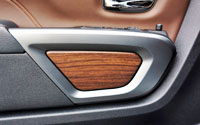
The move up to SV, which costs $52,098 with gas or $59,598 with diesel, swaps out the S model’s basic looking black grille, front and rear bumpers, mirrors and door handles for chrome, while also adding fancier manually-extendable tow mirrors with power-adjustment, heat, integrated turn signal indicators and puddle lights, carpeting instead of Easy Clean Vinyl flooring, an Advanced Drive-Assist Display within the gauge cluster, a larger 7.0-inch colour infotainment touchscreen, satellite radio, a front overhead storage console, skid plates for the oil pan and fuel tank, trailer sway control, a Class IV tow hitch receiver with four-pin/seven-pin wiring, a trailer brake controller and the aforementioned trailer light check, an integrated gooseneck hitch, and front tow hooks.
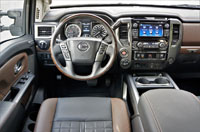
The Pro-4X, at $60,598 with gas or $68,098 with diesel, is Nissan’s sport truck with body-colour paint where chrome would normally go, a nicer cabin featuring embroidered and contrast-stitched upholstery, lots of satin-silver interior trim, and higher-end features like auto on/off signature LED headlights, LED daytime running lights, fog lights, proximity access, a leather-wrapped steering wheel, rain sensing wipers, heatable front bucket seats, a front centre console, an eight-way power-adjustable driver’s seat with powered lumbar support, a four-way powered front passenger’s seat, dual-zone auto climate control, navigation, voice recognition, Siri Eyes Free, NissanConnect Mobile Apps, SiriusXM Traffic and Travel Link, 12-speaker Rockford Fosgate audio, front and rear parking sensors, blindspot warning with rear cross-traffic alert, a centre console-mounted 110-volt power outlet, rear A/C vents, and a power-sliding back window.
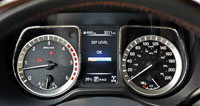
Additional handy Pro-4X conveniences include a lockable rear seat cargo organizer, a rear flat load floor with rear wall tie-down hooks, an electronic tailgate lock, a rear utility bed step, a factory-applied spray-on bedliner, LED under-rail bed and tailgate area lighting, Nissan’s Utili-track Channel System with four tie-down cleats, and a bed-mounted 110-volt AC power outlet, not to mention unique trim-specific off-road equipment such as its electronically-controlled locking rear differential, hill descent control, Bilstein performance shocks, 18-inch alloys wrapped in beefy all-terrain tires, and yet more skid plates for the transfer case and lower radiator.
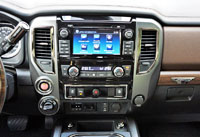
Much of the Pro-4X’ non-sport/off-road related gear gets pulled up to top-line Platinum trim, which starts at $70,998 for the gasoline model and $78,498 for the diesel, and then is added upon with niceties like a chrome exhaust finisher, illuminated running boards, remote engine start with Nissan’s Intelligent Climate Control, metallic kick plates, a heatable steering wheel rim, a powered tilt and telescopic steering column, memory for that steering column, the driver’s seat, and side mirrors, auto-dimming rearview and side mirrors, the latter with reverse tilt-down, a HomeLink universal garage door opener, a 360-degree AroundView parking monitor, NissanConnect/SiriusXM Services, premium leather upholstery, climate-controlled (cooled) front seats, heatable rear outboard seats, and more.
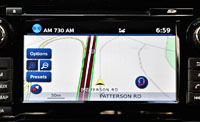
All of these upscale features come in a cabin that’s finished very well, with more soft touch synthetic surfaces than a fully loaded F-Series or Tundra, yet not quite as much as provided by top-line Ram or GM trucks. Where my previous Pro-4X tester was filled with cold hard blacks, whites and silvers, the Platinum gets warm brown tones with stylish orange threading and authentic looking open-pore woodgrain tastefully applied in key areas. The seat upholstery was quite stunning actually, trimmed in a lighter camel brown on the bolsters plus a darker perforated and quilted brown leather at centre, while the driver’s multi-adjustable capability made it especially comfortable, and the steering column’s extensive power reach allowed for ideal ergonomics.
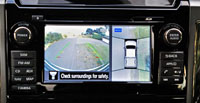
Ahead of that steering wheel is a classy looking two-dial analogue gauge cluster featuring a fairly large colour multi-information display in between. Over on the centre stack, the infotainment touchscreen incorporates an excellent split-screen parking monitor with a traditional rearview camera on the left and an overhead 360-degree view to the right. The navigation system proved easy to use and accurate as well, while that Rockford Fosgate audio system mentioned earlier definitely cranked out the tunes. Overall, the centre stack is well laid out and all of the switchgear quality was on par for the class, but nothing to write home about.
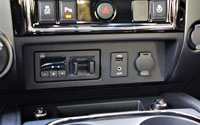
Storage is worthy of a quick note, mind you. Up front are the usual cupholders, but take note they slide back and forth above a large open bin that’s filled with a removable rubber mat for easy cleaning, while the leather armrest/bin cover just behind sits above another large and accommodating bin with its own removable tray, not to mention various connectors, while an aux plug, USB port, and 12-volt charger take care of devices at the base of the dash. As good as that sounds, this truck could use more USB ports and even a wireless charging pad to keep it current. I appreciated the sunglasses storage in the overhead console just the same, despite its strangely oversized nosepiece holder that caused eyewear to flop around inside, a Nissan brand-wide oddity.
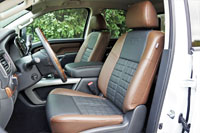
I was impressed with the rear seating area as well. While it’s large and spacious for passengers, the seatbacks also fold flat to store items on top, although flipping them upwards and then folding out the aforementioned rear flat load floor’s carpeted extension is even more useful. It provides a large flat loading area where the seats had been, perfect for storing your belongings safely inside when traveling or on the job site.
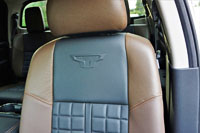
Those side steps mentioned earlier make climbing up to reach over the box walls into the back quite easy, but clambering up to the standard bed when the tailgate is lowered would be difficult for someone small of stature or on in years. Nissan only provides a tiny patch of hard plastic at each corner of the bumper to rest the tip of your boot before swinging upwards, which as anyone who’s lived with trucks knows is a painful slip and fall waiting to happen. Fortunately the kick-down utility bed steps mentioned earlier provide good stable support for climbing up to the tailgate, yet these aren’t part of the standard Titan XD package, which means both import manufacturers really need to catch up to the domestics when it comes to standard bed access, GM especially good in that it provides standard steps integrated within the corners of its rear bumpers.
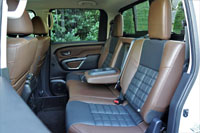
The bed rail system noted earlier works well for tying down cargo, but when it comes time to clean up it’s very challenging to get sticks and debris out from underneath each rail with a regular broom. Likewise the spray-in bedliner was like sandpaper, holding firm to flakes of grass, twigs, and all the other things that get attached after hauling a load or simply parking under a tree, so I’d recommend investing in a power washer if you like to keep your rig clean. Fortunately the grippy surface is an ultra-safe way to make sure you don’t slip and fall in the rain, so I shouldn’t complain.
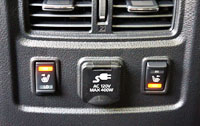
Whether you’re jumping around on the bed, slamming the tailgate shut, doing likewise to the doors, or driving over bumps and dips, the Titan feels as solid as half-ton pickups get, with zero wiggles or creaks in the cabin or anywhere else. It helped that no sunroof was included, which I thought was a bit strange in a top-line truck. This wouldn’t be an issue if Nissan made one available, but alas sun worshipers and stargazers will have to choose another brand if they want a glass roof overhead.
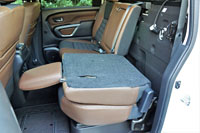
The Titan also comes up short on advanced driver assistance systems, such as forward collision warning, autonomous emergency braking, lane keeping assist, adaptive cruise control, auto high beams, and the list goes on. Nissan has all of the above and much more in its parts bin, but so far these haven’t made it to this Titan XD or the lighter weight Titan.
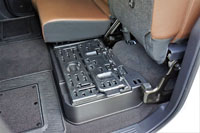
Working to the Titan XD’s advantage is a wonderfully smooth ride, rock steady high-speed cruising ability, and decent at the limit handling, which are all important in a truck with such immediate and plentiful performance. Yes, its big Cummins V8 gets up and goes with gusto, its Aisin-sourced six-speed automatic one gear off the pace when compared to the gasoline-powered Titan, and more so when put up against its domestic rivals, but still a smooth operator and reasonably quick through the cogs. I didn’t get to play with the XD in the mud either, so no opportunity to test its four-wheel drive, which incidentally uses a switch-operated two-speed transfer case. I tested its basic functions on pavement, and can attest to its ultra-easy actuation from 2Hi to 4Hi and 4Lo modes via a dial on the instrument panel, but that’s about it.
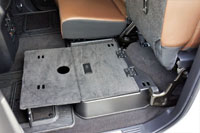
Considering its heavy-half, five-eighths capability you shouldn’t expect the same level of performance found in the lighter Titan or one of its half-ton peers, nor will you find its ride as smooth as either, but then again it’s a bit less of a bruiser than its domestic three-quarter and one-ton rivals, finding a happy medium between the two classes. Also, its double-wishbone front suspension and solid axle/multi-leaf rear setup with stabilizer bars at both ends is more traditional than the coil-sprung Ram, although the Titan’s classic setup is preferred by most towing and hauling fans.
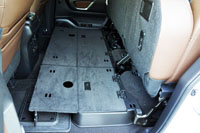
The Titan XD Diesel manages impressive fuel economy too, although being larger than its half-ton sibling it qualifies as a commercial truck and therefore doesn’t need to report mileage info. I can’t even give you an official guestimate by converting U.S. specs to metric, because the same non-rules are in effect there. After my week’s near equal city/highway driving, most of which was easy-going in order to save fuel (I was responsible for filling it up after all), I achieved an average of 13.4 L/100km. That’s very good, but of course expected from an advanced turbo-diesel pulling nothing but its own bodyweight. Factor in that diesel fuel is regularly priced about 20 cents less than regular unleaded in my part of the woods, and that the pricier petrol was hitting $1.55 at some stations last weekend, and then calculate that a diesel-powered vehicle can travel up to 30-percent farther on a tank of fuel, the Titan XD makes a lot of sense even with its $7,500 upcharge.
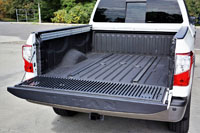
Whether or not the Titan is capable of pulling its own weight from a business case perspective is still open to question. It’s certainly finding new buyers at a rapid rate, and despite lagging behind the Tundra and all domestics in sales, it’s a stronger seller than some other Nissan models and most Infinitis, while its long-term potential is too good to pass up.
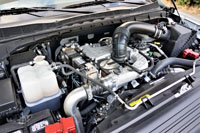
No other vehicle class in Canada boasts models selling into six-figure territory, not to mention the near seven figures Ford’s F-Series achieves south of the 49th. That’s why Nissan and Toyota stepped into the full-size pickup arena in the first place, and why they’ll likely stick it out over the long haul. Just the same, automakers like Hyundai and Volkswagen might want to hold back before entering the fray, as the cards are stacked against success in this segment. It’s not just about building a worthy full-size pickup truck contender, as Nissan has learned, because breaking through brand loyalty barriers has proven difficult enough for those already steeped in compact pickup heritage, let alone carmakers that have never offered a serious truck in our market.
The Titan might be the most credible import offering to date, hitting at the core of the full-size half-ton market, and even creating its own unique niche by taking a half-step up on every competitor with this innovative five-eighths, heavy-half Titan XD. Now with a more complete line of engines, it’s a force to be reckoned with and therefore should slowly, steadily pull buyers into its alternative camp.

